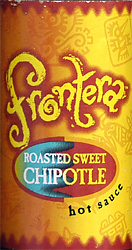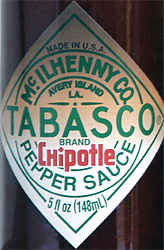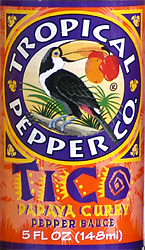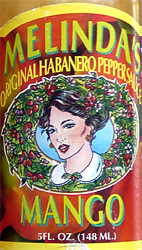|
Hot stuff!
Some like it hot. And some like it even hotter. That's the Jack Spratt situation in which my long-suffering wife and I occasionally find ourselves. While I wouldn't drown the flavors of subtle and delicate dishes under a wave of peppery heat (imagine, if you will, Jamaican jerk foie gras), I do enjoy a good dose of capsaicin ("Cap-SAY-uh-sin," the chemical compound that gives hot peppers their fire) where it's indicated. I'll eagerly ask for four-star heat at my favorite Thai spot and occasionally risk five. My spouse will compromise on two stars but would really rather go with one. When we're eating at home, the solution is simple: If I fashion a dish from the mostly tropical cuisines that favor fire, whether it's an Indian vindaloo or Cajun gumbo, I'll make it with moderate heat for Mary, then light the afterburners with an appropriate dose of hot sauce on my serving. There's a world of hot sauces out there, and although I'll still nod with respect to the classic Tabasco and French's Hot Sauce of my youth, I've long since moved on to more exotic realms. I've even toyed with some of the extreme sauces, many of them based on the hellish habanero, that trumpet their pain level with names like "Insanity" and "Quadruple Hell." But to be honest, most of those take it too far for me. I like a sauce that backs up its heat with interesting, even complex flavors ... for the same reasons why I would usually choose a Chateauneuf-du-Pape over a Turley Zinfandel. If I had to name a single hot sauce, it would probably be in the Southeast Asian family that includes Indonesian sambal oelek; particularly Sriracha Hot Chile Sauce and Chili Garlic Sauce, made in the U.S. by Huy Fong Foods in the Los Angeles area. Bright red and fiery enough that a little dab'll do ya, these sauces - which you'll almost always find on the table in Vietnamese restaurants - stand out for me because of their bright, clean flavors. For today's article, I thought it would be fun to switch from the usual recipe to a wine-tasting-style report on five unusual specialty sauces that I've sampled recently. The first three sauces, including a new entry from Tabasco, are based on chipotle peppers - jalapeñoes that have been smoked over wood fires to impart a smoky flavor that (sort of like oak in wine) can be subtle or overwhelming depending on the sauce-maker's art. The last two sauces feature intriguing blends of hot peppers and fruit. I tried them all under casually analytical conditions similar to my wine tastings, sampling them first alone (with plenty of water for palate-clearing), then with food (small bites of rare ribeye steak).
Those of you who've switched over to our new HTML/graphics edition will see photos of the labels alongside each tasting report. If you're reading our text version, you can view the labels, if you wish, by clicking to the archived edition of today's article,  Frontera Roasted Sweet Chipotle Hot Sauce
Frontera Roasted Sweet Chipotle Hot Sauce
This chipotle sauce, bottled for distribution by Chef Rick Bayless's Frontera Grill in Chicago, is a relatively thin, dark-brown sauce with suspended bits of chipotle pepper and tomatillo, prompting the label to suggest shaking well to "unleash the flavor." The smoky aroma is quite dominant, with a bit of a sulfury edge. The flavor is hot-sweet and smoky, with a back-of-the-throat heat that I associate with cayenne pepper. Much more enjoyable with a bite of steak, which seems to round out the flavors.  El Yucateco Chipotle Hot Sauce
El Yucateco Chipotle Hot Sauce
This made-in-Mexico brand has long been a favorite for both its red and green habanero-based sauces, which are a fixture at most of the more authentic Mexican restaurants hereabouts. This is a thick, smooth, dark-brown sauce with a distinctly smoky chipotle aroma and flavor over a sweet-tart vinegar and sugar base. With steak its flavor blossoms with a remarkable and delicious dark-chocolate note over the smoke.  Tabasco Chipotle Pepper Sauce
Tabasco Chipotle Pepper Sauce
This new product from McIlhenny Co. in Avery Island, La., appears to be standard Tabasco brand sauce plus chipotles, and the formula works very well. The sauce is reddish-brown in color, lighter than the other chipotle sauces. The smoky aroma is clean and appetizing - it reminds me of hanging around a barbecue pit when meat is being smoked - and the hot-smoky-sweet flavor is relatively gentle ... although it still packs a punch. With steak, the pepper flavors take on an intriguing and pleasant fruity quality.  Tropical Pepper Co. Tico Papaya Curry Pepper Sauce
Tropical Pepper Co. Tico Papaya Curry Pepper Sauce
Made in Costa Rica, this is a fairly thick, reddish-brown sauce with distinct curry-powder aromas and flavors over ripe, sweet fruit. Its heat level is only medium, but the curry and fruit combination adds considerable flavor in appropriate settings; steak seems to highlight the fruit.  Melinda's Mango Original Habanero Pepper Sauce
Melinda's Mango Original Habanero Pepper Sauce
The original Melinda's brand was made in Belize, and hot-sauce enthusiasts argue endlessly over whether the sauces got better or worse after a management change and move to Costa Rica years ago. The resemblance of this discussion to a wine-geek debate over pre- and post-phylloxera Bordeaux is probably not merely coincidental. But I find no cause for debate over the quality of Melinda's relatively recently introduced Mango Sauce, which is one of the best fruit-based hot sauces. Peach color and pureed in texture, it presents a good balance of sweet fruit and clean, intense but medium heat, with steak or just about any dish.
Tell me about your hot-sauce favorites! If you want to recommend a hot sauce that you enjoy, or otherwise comment about today's topic (or even tell me that you really wish I would stick with the recipes instead of doing this kind of thing) drop me a line at WINE MATCH: Despite my enthusiasm for wine, I don't usually choose it with fiery fare. I find that the alcohol interacts with the capsaicin and turns the usually pleasnt "burn" into something more painful. Depending on the cuisine and my mood, I'll go with a cold beer; or for authenticity, consider the drinks that the people of the local culture choose: Sweet fruit drinks with Mexican, iced tea with Cajun, or most effective of all at cooling the fires, dairy-based beverages like the Indian yogurt lassi or sweet, cream-topped Thai or Vietnamese coffee. If you're absolutely set on wine with fiery fare, though, try something slightly sweet - Riesling will work well - or a modest sparkling wine. Or combine both sweet and bubbly, if you're willing to risk the disdain of wine snobs: A sweeter-style Australian Sparkling Shiraz, the Italian Asti Spumante, or even the often maligned Lambrusco will work surprisingly well with the spiciest foods on your table. Let us hear from you! If you have suggestions or comments about The 30 Second Wine Advisor's FoodLetter, or if you would like to suggest a topic for a coming edition and recipe, please drop me a note at wine@wineloverspage.com. I really enjoy hearing from you, and I try to give a personal reply to all mail if I possibly can.
You are also invited to join the conversations in our interactive Food Lovers' Discussion Group. To participate in this friendly online community, simply click to Last Week's FoodLetter and Archives
• Last week's Wine Advisor Foodletter: Mastering the omelet (Feb. 6)
• Wine Advisor Foodletter archive:
• 30 Second Wine Advisor archive: This is The 30 Second Wine Advisor's weekly FoodLetter. To subscribe or unsubscribe, change your E-mail address, or for any other administrative matters, please use the individualized hotlink found at the end of your E-mail edition. If this is not practical, contact me by E-mail at wine@wineloverspage.com, including the exact E-mail address that you used when you subscribed, so I can find your record. Thursday, Feb. 13, 2003Copyright 2002 by Robin Garr. All rights reserved. FoodLetter archives Subscribe to the 30 Second Wine Advisor
|




